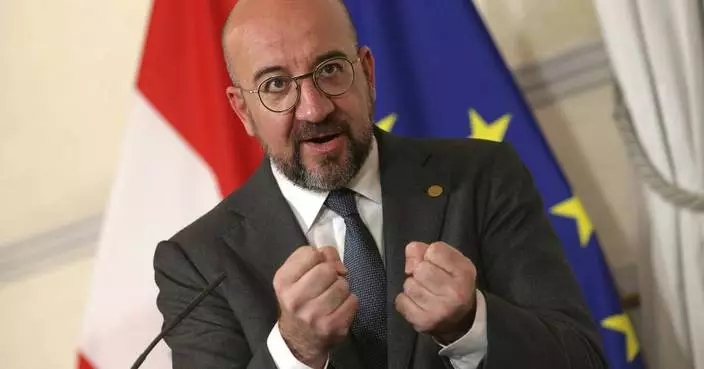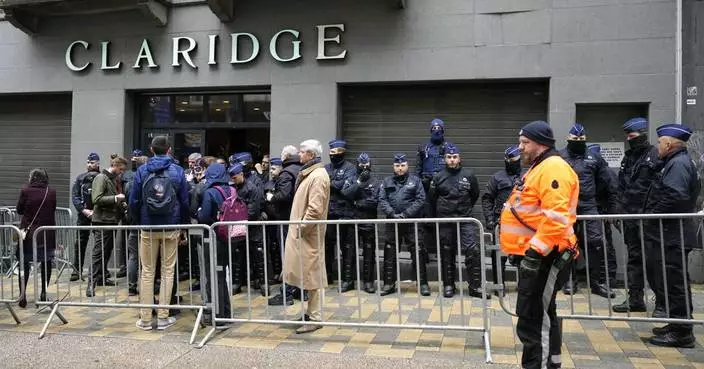For much of Russian-French Modernist painter Marc Chagall's life, which took him from a tiny village in rural Russia to St. Petersburg, Paris and New York, he remained remarkably faithful to eight pigments in his colorful works, according to new research unveiled Friday at Amsterdam's Stedelijk Museum.
Experts at the museum spent five years minutely studying nine paintings by the artist, who blended modernist styles such as Cubism and Fauvism in works on surfaces ranging from traditional canvases to ceramics, stained windows, an opera house ceiling and even a tablecloth.
"One of the things that struck me really was that he's so consistent in the materials that he used. Eight pigments that he used these 35 years," said Paintings conservator Meta Chavannes. "That's quite striking I think even though he moved around so much."
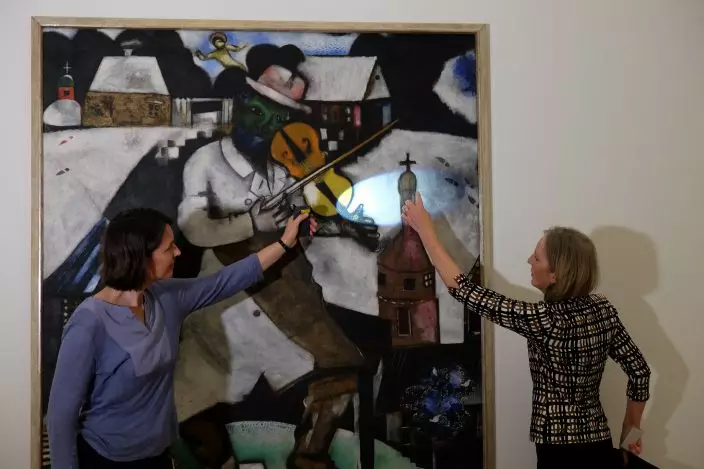
Stedelijk Museum Conservators Meta Chavannes and Madeleine Bisschoff point at March Chagall’s painting “The Fiddler” in Amsterdam, Friday, Sept. 13, 2019, during a presentation of results of a five-year research project into the painter. New research shows that for much of Russian-French Modernist painter Marc Chagall's life, which took him from a tiny village in rural Russia to St. Petersburg, Paris and New York, he remained remarkably faithful to eight pigments in his colorful works. (AP PhotoMike Corder)
And while Chagall's paintings, infused with folk references and surreal touches, can appear whimsical, Chavannes said he was guided at times by the material he painted on, including a checkered tablecloth for one of his most famous works, "The Fiddler."
"One of the things that was really interesting was ... to find out how pragmatic he was," Chavanne said. "Using this tablecloth, this grid pattern and filling in the checks. ... They're not particularly figurative, they don't tell the story, but he obviously felt compelled to fill in those shapes."
A technique using infrared light to peer through the surface paint layers revealed that the canvas used for "The Synagogue at Safad, Israel" has a different scene underneath the paint.
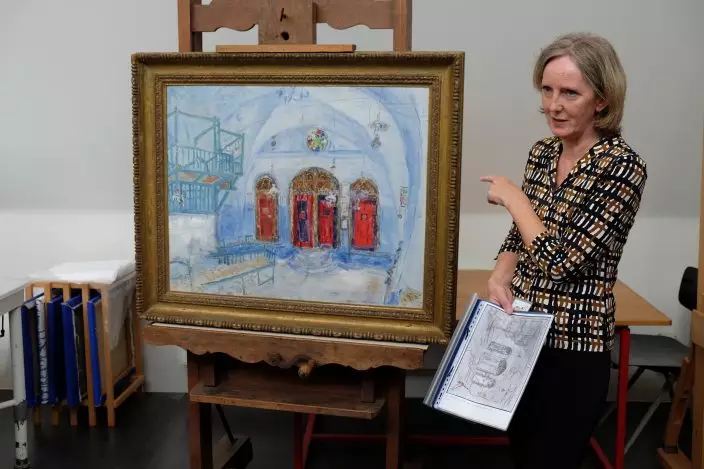
Stedelijk Museum Conservator Madeleine Bisschoff points at Marc Chagall’s painting “The Synagogue at Safad” in Amsterdam, Friday, Sept. 13, 2019, during a presentation of results of a five-year research project into the painter. New research shows that for much of Russian-French Modernist painter Marc Chagall's life, which took him from a tiny village in rural Russia to St. Petersburg, Paris and New York, he remained remarkably faithful to eight pigments in his colorful works. (AP PhotoMike Corder)
If the painting is turned a quarter, the drawing underneath bears striking similarities to another Chagall painting, "Ida at the Window," a portrait of the artist's daughter.
The museum says the results of the research will be of value to art historians and conservators around the world who may want to restore the 20th century artist's works.
Eight of the museum's nine Chagall paintings will be included in an exhibition opening Sept. 21 titled "Chagall, Picasso, Mondrian and others: Migrants in Paris.
WARSAW, Poland (AP) — Polish Prime Minister Donald Tusk expressed satisfaction on Monday after a series of candidates supported by his party won weekend races for mayor.
Candidates from his pro-European Union centrist Civic Coalition, or running with the party's backing, won in a series of cities in the second round of local elections held on Sunday, among them Krakow, Poznan, Wroclaw and Rzeszow.
“It is very difficult to clearly say who won and who lost,” Tusk said Monday. “But if we compare these results, especially in the most attractive places, on these attractive battlefields ... then I actually have reasons for satisfaction.”
“Law and Justice has simply disappeared in many places,” Tusk added at a news conference, referring to the main opposition party.
The results put Civic Coalition in a favorable position as the country looks next to elections to the European Parliament on June 9.
Mayors were chosen in a total of 748 cities and towns where no single candidate won at least 50% of the vote during the first round on April 7.
Candidates for Tusk’s party also recaptured cities where they had not held power for many years, including Zielona Gora, Legnica and Torun.
The local and regional elections were viewed as a test for Tusk's pro-European Union government four months after it took power at the national level. Sunday's second round strengthened the Tusk government's leverage in the cities, which should facilitate cooperation on development projects and allotment of EU funds.
Tusk's allies also won in some places in the first round two weeks ago, including in Warsaw, where incumbent Mayor Rafal Trzaskowski was an easy victor.
In the first round, the right-wing Law and Justice, prevailed on the level of regional assemblies in the country's 16 provinces, where it took 34.3% of the votes, while Tusk's Civic Coalition got 30.6%. Law and Justice governed on the national level from 2015-23.
Tusk’s socially liberal Civic Coalition traditionally has strong support in cities, while Law and Justice has a more solid base in conservative rural areas, particularly in eastern Poland.
Civic Coalition is the largest group in a three-party coalition that governs the EU nation of 38 million people. The coalition is pro-European Union but otherwise spans a wide ideological spectrum with left-wing politicians in the Left party as well as conservatives in the Third Way.
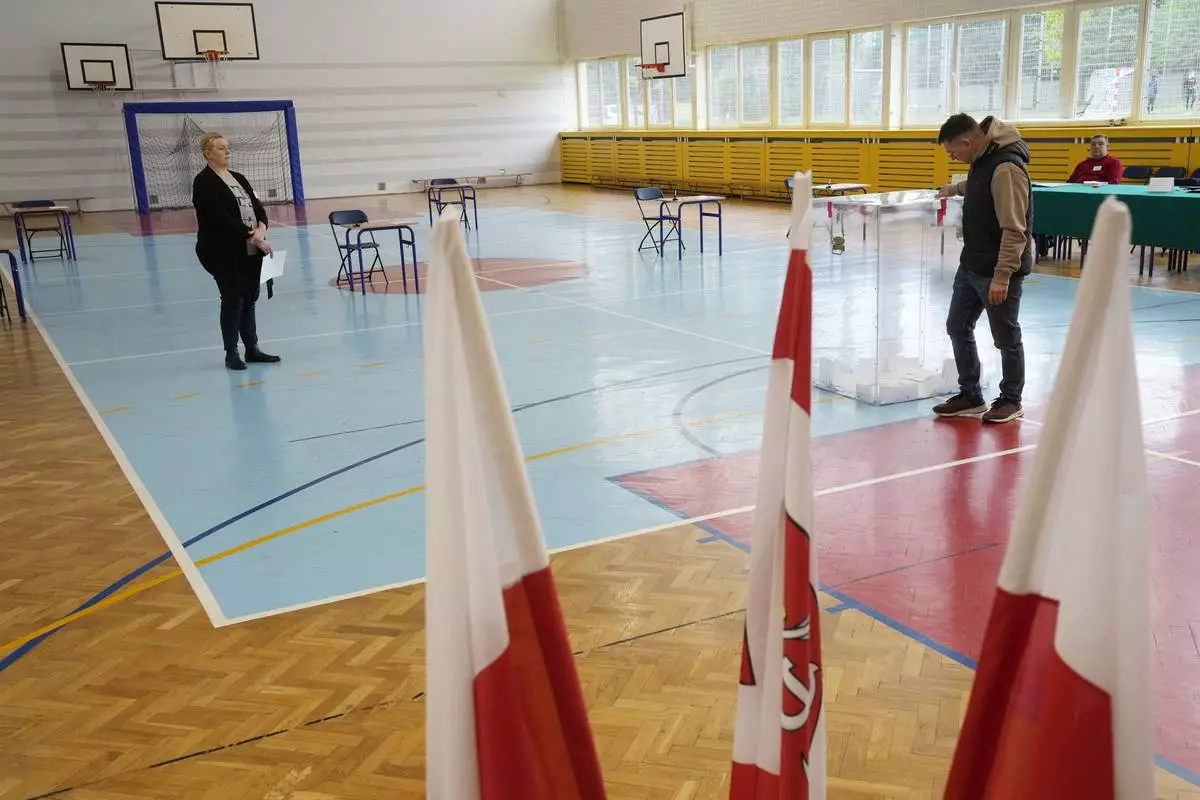
Polish voters take part in a local runoff election in Lomianki, near Warsaw, Poland on Sunday, April 21, 2024. Voters are choosing mayors who did not win outright in the first round of the election two weeks earlier. (AP Photo/Czarek Sokolowski)
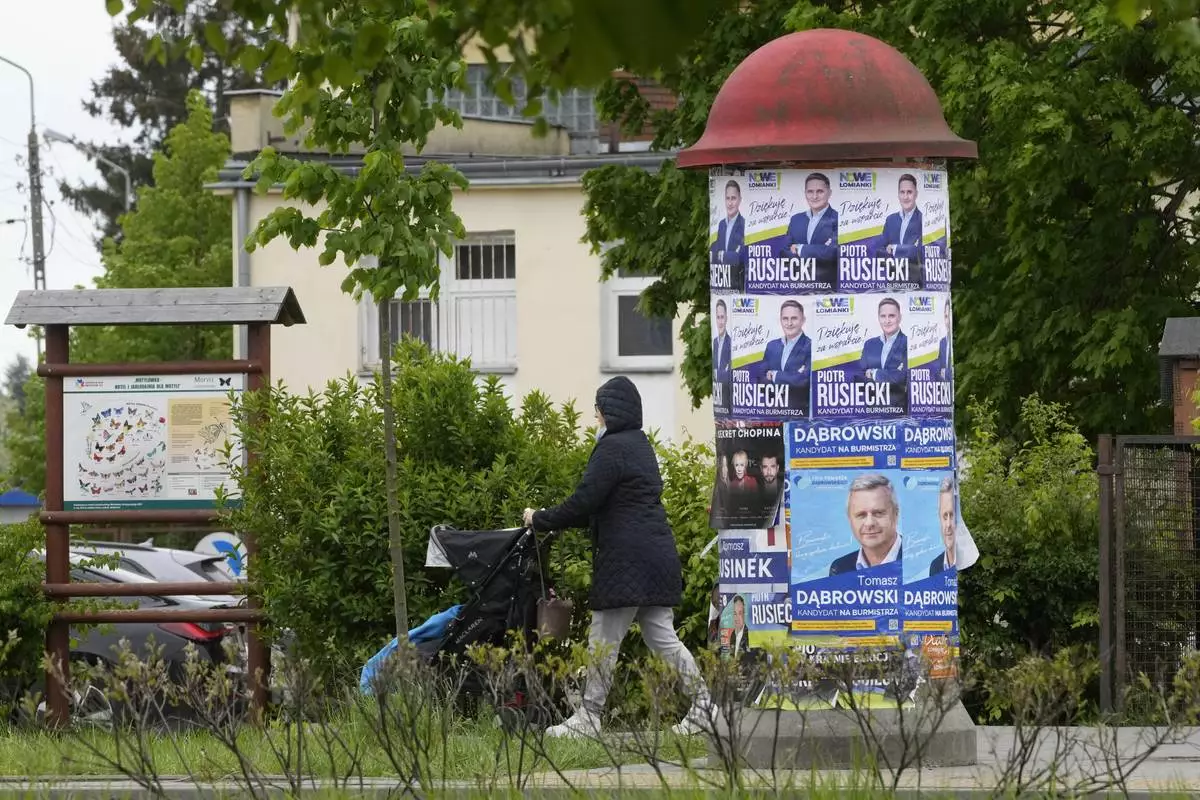
Campaign posters promote candidates as Poles vote in local and regional elections in Lomianki, near Warsaw, Poland on Sunday, April 21, 2024. Voters are choosing mayors who did not win outright in the first round of the election two weeks earlier. (AP Photo/Czarek Sokolowski)
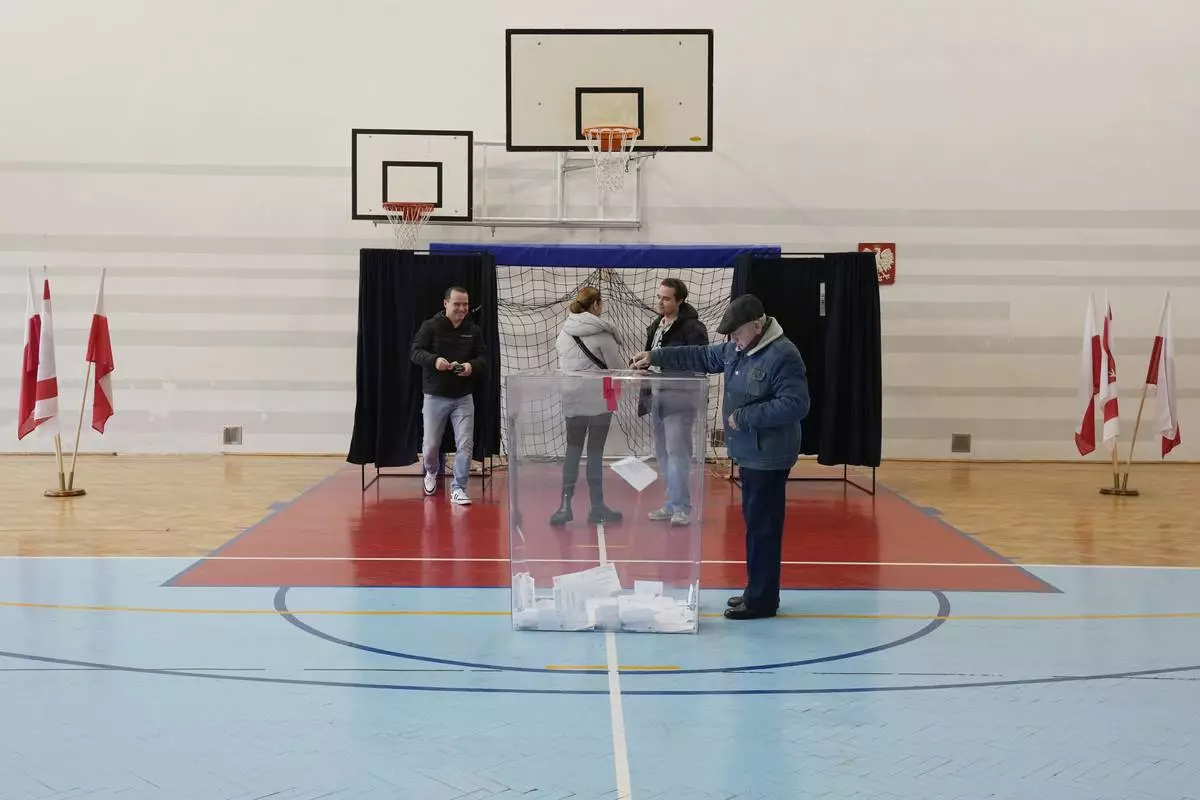
Polish voters take part in a local runoff election in Lomianki, near Warsaw, Poland on Sunday, April 21, 2024. Voters are choosing mayors who did not win outright in the first round of the election two weeks earlier. (AP Photo/Czarek Sokolowski)
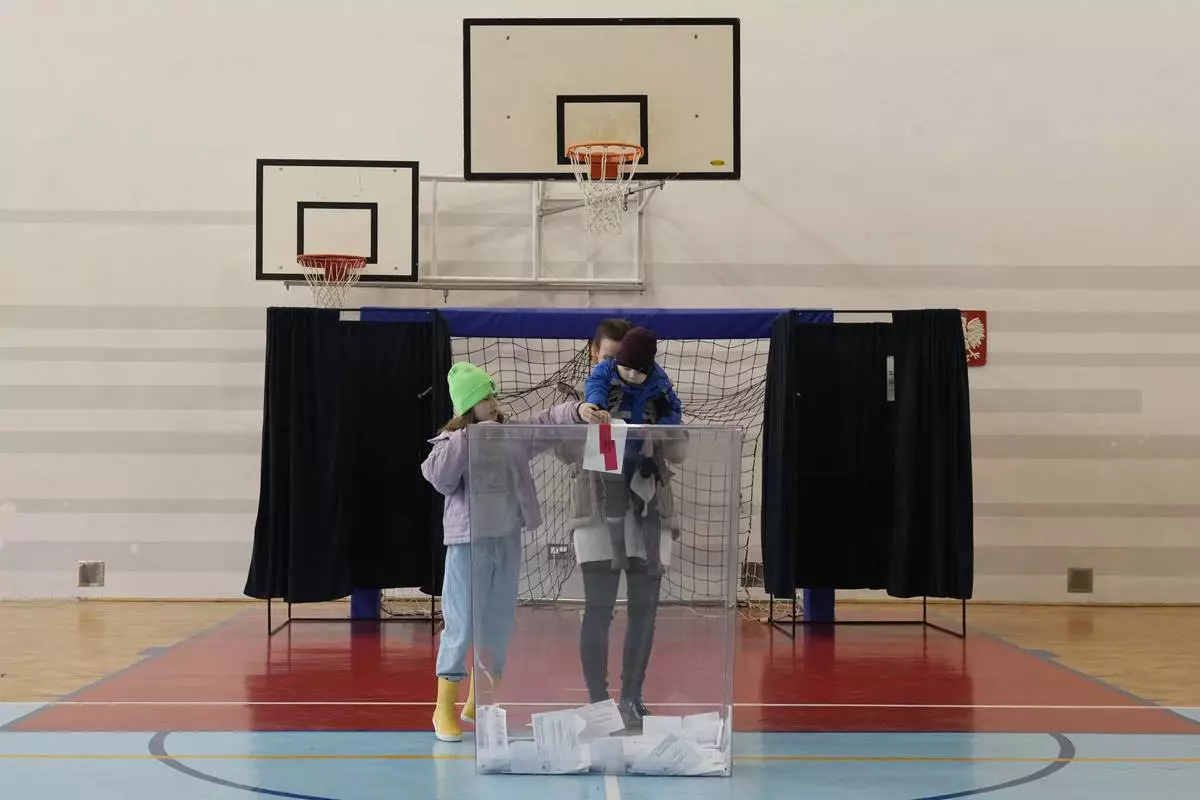
Polish voters take part in a local runoff election in Lomianki, near Warsaw, Poland on Sunday, April 21, 2024. Voters are choosing mayors who did not win outright in the first round of the election two weeks earlier. (AP Photo/Czarek Sokolowski)

FILE - Poland's Prime Minister Donald Tusk reacts during his and Ukrainian President Volodymyr Zelenskyy meeting with students in Kyiv, Ukraine, Monday, Jan. 22, 2024. Poland's Prime Minister Donald Tusk is celebrating a victory on Monday April 22, 2024 after a series of candidates supported by his party won weekend races for mayor. (AP Photo/Efrem Lukatsky, File)
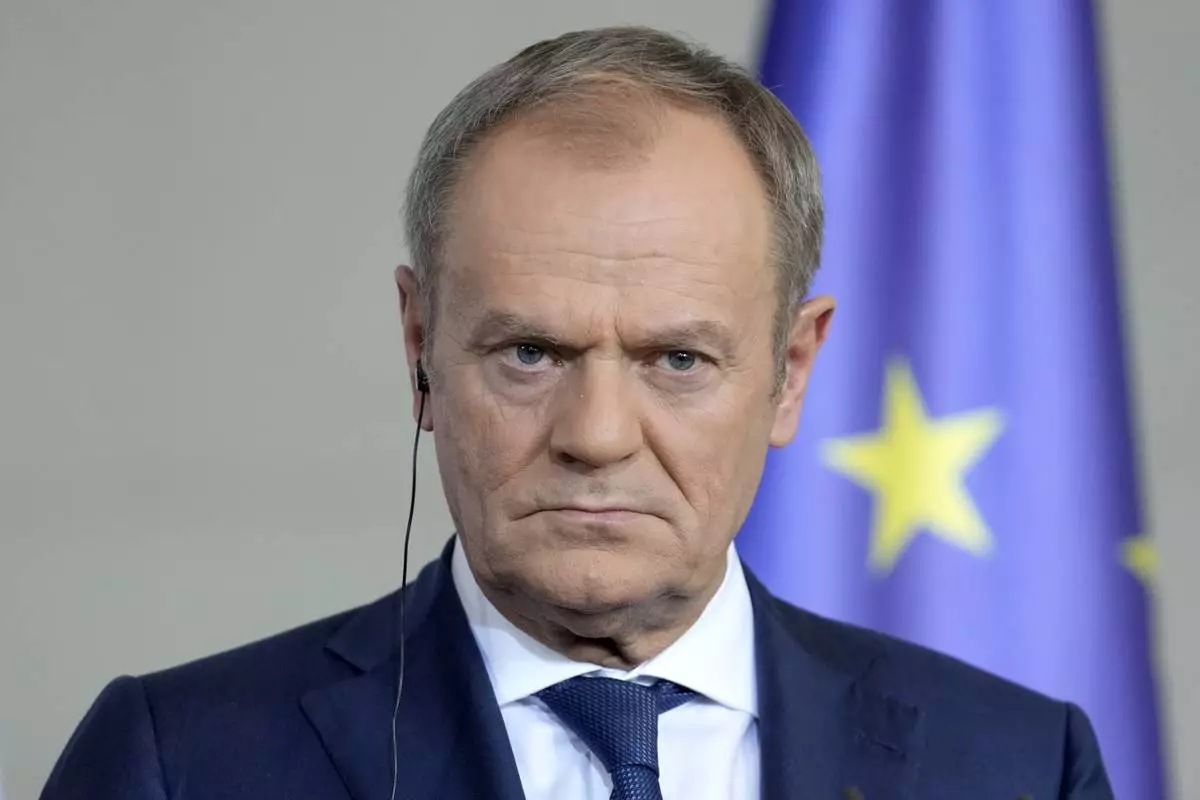
FILE - Poland's Prime Minister Donald Tusk listens to the media in Berlin, Germany, Friday, March 15, 2024. Tusk is celebrating a victory on Monday April 22, 2024 after a series of candidates supported by his party won weekend races for mayor. (AP Photo/Ebrahim Noroozi, File)














